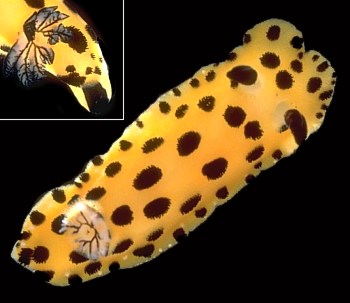
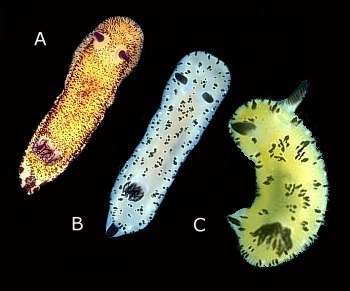
Jorunna sp. 2.
Order: NUDIBRANCHIA
Suborder: DORIDINA
Superfamily: EUDORIDOIDEA
Family: Dorididae
PHOTO
UPPER: Kurnell, Botany Bay, NSW, May 1986, 21 mm long. Inset showing black band on posterior foot of animal from Green Point, Camp Cove, Sydney, 6m, October 1982.
LOWER: A, Long Reef, Sydney, March 1980, 17mm long. B, Coffs Harbour region, northern New South Wales, Dec 1990, 15mm long. C, juvenile Lizard Is., North Queensland, June 1979, 11mm long. PHOTOS: Bill Rudman.
Usually yellow with black spots, this unnamed species appears to be widespread throughout the Indo-West Pacific. In some cases it can have a white background colour, and sometimes the black patches are replaced by scattered black caryophyllidia all over the mantle. It differs from Jorunna funebris in radular morphology and in having many more gills, and a large black spot or line on the posterior tip of the foot.
Compare also with Jorunna pardus from California and Jorunna parva from Japan.
Authorship detailsRudman, W.B., 1999 (October 23) Jorunna sp. 2. [In] Sea Slug Forum. Australian Museum, Sydney. Available from http://www.seaslugforum.net/find/jorusp2
Related messages
Jorunna? from West Papua
May 24, 2007
From: Jim Anderson
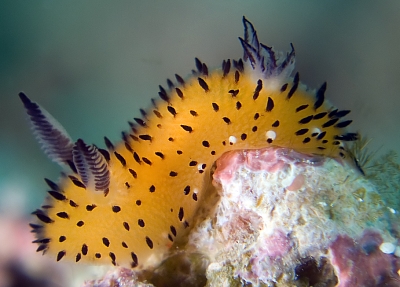
Dear Bill,
I think these are what you have been calling Jorunna sp. 2. They were taken by me during a recent trip to Raja Ampat in West Papua, Indonesia and some details follow
Upper: 8 March; depth, 6 metres; site Aerborei Island Jetty; steep coral rubble slope ; length 15 mm
Lower: 8 March; depth, 10 metres; site East Fam Wall, Penemu Island; coral reef slope ; length 15 mm
Kind regards,
Jim Anderson
Scottish Nudibranchs
jander4454@gmail.com
Anderson, J., 2007 (May 24) Jorunna? from West Papua. [Message in] Sea Slug Forum. Australian Museum, Sydney. Available from http://www.seaslugforum.net/find/19934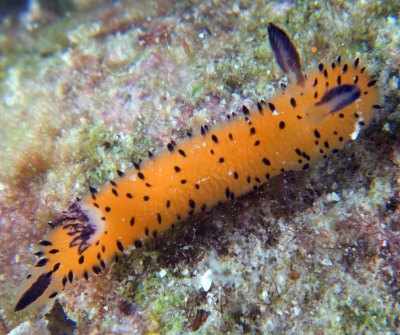
Dear Jim,
Yes this is probably what I have been calling Jorunna sp. 2, but I think it is the same as Baba's Jorunna parva.
Best wishes,
Bill Rudman
Jorunna sp. 2 from Anilao, Philippines
June 13, 2003
From: Ray Izumi
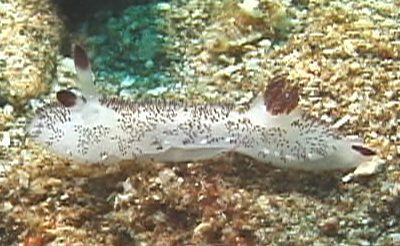
Dear Bill
Here's another of the interesting nudies we recently found in Anilao, Philippines. It's not a great photo but hopefully there's enough for an ID. Is it a Chromodoris?
Ray Izumi
izumirm@sprynet.com
Izumi, R., 2003 (Jun 13) Jorunna sp. 2 from Anilao, Philippines. [Message in] Sea Slug Forum. Australian Museum, Sydney. Available from http://www.seaslugforum.net/find/10151Dear Ray,
This is an animal which I am calling Jorunna sp. 2 on the Forum.
Best wishes,
Bill Rudman
Jorunna from Durban, South Africa
June 9, 2001
From: Kirsty Miller
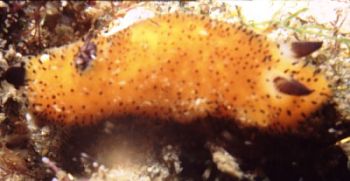
Dear Bill,
I found this nudibranch at a depth of 2m on a recent dive on Vetches' Pier, a rubble artificial reef at the entrance to Durban Harbour, South Africa.
My father photographed it as part of a school project I am doing. Could you please help me with an identification.
Kirsty Miller
divegirl@xsinet.co.za
Miller, K., 2001 (Jun 9) Jorunna from Durban, South Africa. [Message in] Sea Slug Forum. Australian Museum, Sydney. Available from http://www.seaslugforum.net/find/4494Dear Kirsty,
This is a species of Jorunna which I have been calling Jorunna sp. 2. It is found throughout the Indo-West Pacific and appears quite variable in colour, ranging from the colour form in your photo to a form where the black caryophyllidia are aggregated into prominent black spots.
Best wishes,
Bill Rudman
Jorunna sp. 2 from South Africa
July 12, 2000
From: Valda Fraser
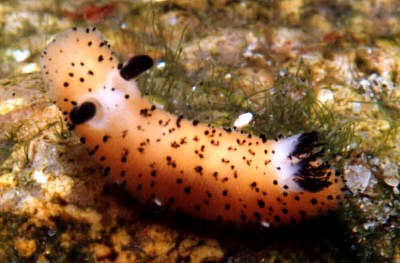
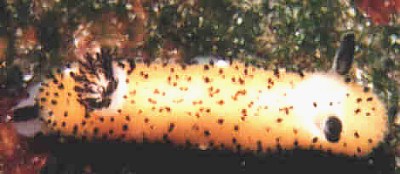
Dear Bill
Please help! I cannot offer any ideas. Thanks.
Locality: Pumula, south coast KwaZulu-Natal, SOUTH AFRICA - intertidal zone
Date: July 2000
Size: 18mm
Regards
Valda Fraser
iti04937@mweb.co.za
Fraser, V., 2000 (Jul 12) Jorunna sp. 2 from South Africa. [Message in] Sea Slug Forum. Australian Museum, Sydney. Available from http://www.seaslugforum.net/find/2681Dear Valda,
This is the species of Jorunna I have been calling Jorunna sp. 2. As you will see at the top of the page, this species is quite variable in colour, sometimes with large rounded spots, sometimes with scattered black specks. One distinguishing character is the median black band on the posterior tip of the foot, Fortunately in your second photo this is clearly visible.
As I discussed recently, it has close similarities to a form of Jorunna parva. Like Rostanga, species of Jorunna have a very 'bristly' back as their mantle is covered in caryophyllidia, which are small tubercles bearing a crown of pointed spicules. See Jorunna funebris for an illustration.
Best wishes,
Bill Rudman.
Jorunna sp. 2 in Sydney
June 20, 2000
From: P.Zylstra & H.Rothenfluh
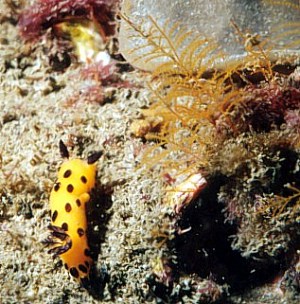
Hi,
We found this Jorunna sp. at the Monument at Kurnell, Sydney [NSW, Australia] in 10m. It was about 2 cm in length.
Cheers
Paula Zylstra
Harry Rothenfluh
hsrpz@netspeed.com.au
Zylstra,P. & Rothenfluh,H., 2000 (Jun 20) Jorunna sp. 2 in Sydney. [Message in] Sea Slug Forum. Australian Museum, Sydney. Available from http://www.seaslugforum.net/find/2587Dear Paula & Harry,
Thanks for the photo.
Best wishes,
Bill Rudman.
Re: Is this a Jorunna sp??
November 1, 1999
From: Erik Schloegl
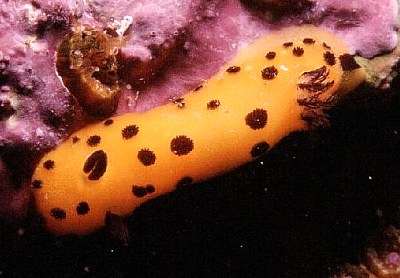
Dear Bill,
This is a nudibranch I've been wondering about for a long time, too. It's certainly one of the more common species along the New South Wales coast. The attached photo was taken at Long Reef (just off Sydney's Northern Beaches), on June 14, 1999, at a depth of about 15m. Whenever I see this species I wonder why it hasn't been described yet and what it takes to describe a (nudibranch) species. Could you comment on this?
Thanks,
Erik Schloegl
schloegl@maths.uts.edu.au
Schloegl, E., 1999 (Nov 1) Re: Is this a Jorunna sp??. [Message in] Sea Slug Forum. Australian Museum, Sydney. Available from http://www.seaslugforum.net/find/1456Dear Erik,
Yes it is what I am calling Jorunna sp. 2 - which is the easiest part of your question to answer.
What does it take to describe a species? is not so easy. Once you have decided a 'species' is distinct from all others and does not already have a name, you can name it by publishing an 'adequate' description in a reputable scientific journal. You need to follow the International Code of Zoologcial Nomenclature, which has just been revised, but apart from that you are effectively on you own. Now if you say all that very quickly it seems quite simple, however, as with most things, it is not quite as simple as it at first may appear.
Firstly, the underlying rule of the International Code, is the Law of Priority. Basically the first valid name given to a species has priority over all subsequent names.
Secondly, most practising taxonomists consider the binomial naming system we use is more than just a process to give unique names to all organisms. Modern nomenclature attempts to reflect, to the best of our ability, the evolutionary, or phylogenetic realtionships between the organisms. If you look at the Species List the various categories such as ORDER, SUPERFAMILY, FAMILY etc should not be thought of so much as a hierarchy, but as a grouping, at each level, of organisms with a common ancestry. The naming system should be a simple way to show evolutionary relationships. All species in Genus 1 are more closely related to each other than they are to species in Genus 2. All species in Family 1 are more closely related to each other than they are two species in Family 2 etc.
Discovering whether your 'new' species already has a name, is a major problem. In earlier times, species were often named in a very cursory manner, often a 3 line (not three sentence) description, with no illustration was considered sufficient. In many parts of the world there are still considerable debates about the identity of some early names, and until many of these early names are better understood, there will continue to be problems.
Understanding relationships between species is also a time-consuming task, requiring the comparative studies on the anatomy of the relevant species. In the past, many workers who thought they had a new species just published it as "A new species from X" or "A new species of the genus X", with little consideration for biogeography, phylogenetic relationships etc. Or else we had papers on "A collection of species from my summer holidays" where again no consideration was given to the phylogeny of the species involved, which could include a sacoglossan, an aeolid, a dorid etc. Today, most professional workers consider it necessary to describe new species in the context of a review of related species. Only in cases where the relevant genus has recently been adequately reviewed, is there much point in publishing single species descriptions.
Some years ago I reviewed the genus Rostanga (see Rudman & Avern,1989) which is quite similar to Jorunna in external features, other than colour. At that time I began accumulating and dissecting specimens of Jorunna-like animals for a similar publication. It is still in preparation, not through lack of effort, but through the need to collect more specimens of some of the problematic species. To name this black-spotted species is less important to me than understanding the relationships of the group. Naming new species should not be a 'race'. It should be the result of some substantial and professional effort.
Unfortunately, taxonomy is the one science where you can't ignore the work of the incompetent. I would dearly love to declare the work of certain authors invalid simply on the basis that their descriptions are so inadequate that it is impossible to understand what they are talking about. The problem with such a dictatorial approach however is deciding who would have the power to ban an author's work, and would it be a ban on all their work or just some of it. Suffice to say that I am forced to spend much longer searching the literature and interpreting old descriptions than I spend dissecting the animals.
I hope that gives you some idea of the problems involved ..... and I haven't even mentioned the problem of defining what is a species. From the photos showing colour variation in Jorunna sp. 2 and Jorunna funebris you can see that we can't just assume that species can be defined by colour patterns alone.
Bill Rudman.
Rudman, W.B., 1999 (Nov 1). Comment on Re: Is this a Jorunna sp?? by Erik Schloegl. [Message in] Sea Slug Forum. Australian Museum, Sydney. Available from http://www.seaslugforum.net/find/1456Crimora sp? from South Africa
October 25, 1999
From: Ernest C.J. Seamark

Dear Bill,
Gosliner (1987) found this species from Algoa Bay in SA. One individual was collected on 17 September 1997 from the intertidal zone of Treasure Beach. What is its species ID and this increases its distribution from the temperate waters of South Africa, into the indo-Pacific.
[Treasure Beach is in Durban, KwaZulu Natal, South Africa.]
Ernest Seamark
kearneyt@biology.und.ac.za
Seamark, E.C.J., 1999 (Oct 25) Crimora sp? from South Africa. [Message in] Sea Slug Forum. Australian Museum, Sydney. Available from http://www.seaslugforum.net/find/1042Dear Ernest,
This species certainly has resemblances to the polycerid, Crimora lutea, but it is in fact an aberrant colour form of Jorunna sp. 2.. That species usually has scattered black patches or spots all over the mantle, each spot being made up of a group of black caryophyllidia. However in your animal the black caryophyllidia are scattered singly over the mantle. [Caryophyllidia are spiculate papillae found in a number of dorid genera]. Even though your photo is a little blurred, the characteristic black patch on the posterior tip of the foot is quite clear. Have a look at the photos on the Jorunna sp. 2. page to see a range of colout variants, including one (A) from eastern Australia which is almost identical to your photo.
Both species seem to have a wide distribution in the tropical and warm temperate Indo-West Pacific.
Bill Rudman.
Rudman, W.B., 1999 (Oct 25). Comment on Crimora sp? from South Africa by Ernest C.J. Seamark. [Message in] Sea Slug Forum. Australian Museum, Sydney. Available from http://www.seaslugforum.net/find/1042Is this a Jorunna sp??
October 24, 1999
From: Des Paroz
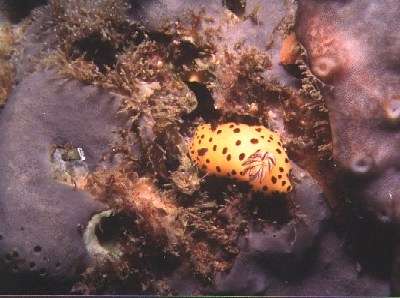
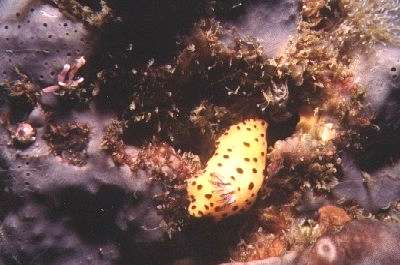
Hi Bill
I spotted this slug on a dive at Toothbrush Island, Wollongong, southern New South Wales, last Sunday (17/10/99).
It was sitting at a depth of about 14m on a wall. Water temp was about 17C - there appears to have been a warm current since the previous week, as temp jumped about 3C.
It looks like a critter referred to be Debelius as Jorunna sp., however it doesn't look at all like the Jorunna sp. on the Seaslug Forum.
Any information would be much appreciated.
Best regards
Des Paroz
www.divesite.paroz.com
des@paroz.com
Paroz, D., 1999 (Oct 24) Is this a Jorunna sp??. [Message in] Sea Slug Forum. Australian Museum, Sydney. Available from http://www.seaslugforum.net/find/1447Dear Des,
'Jorunna sp.' is just shorthand for 'a species of Jorunna which either is unnamed or I don't know its name'.
In this case your nudibranch is an unnamed species of Jorunna which seems to have quite a wide distribution in the Indo-west Pacific. It usually has a yellow background colour but can be quite white which confuses it with small animals of Jorunna funebris.
I suspect the grey sponge in both the photos is its food. If by chance you actually see it feeding or with its mouth in an excavated hole, a photo would be very valuable evidence.
I have renamed Jorunna sp, Jorunna sp. 1 in the Forum. It is also an unnamed species, so for convenience, I am calling the black-spotted one 'Jorunna sp. 2'.
Best wishes,
Bill Rudman.
